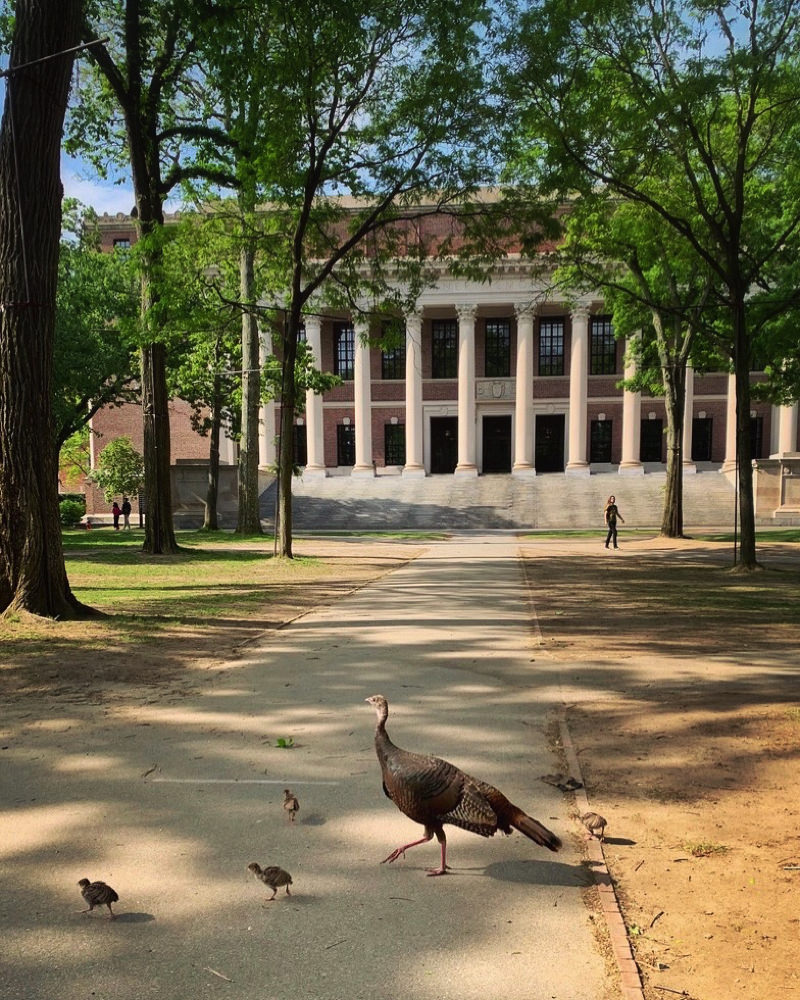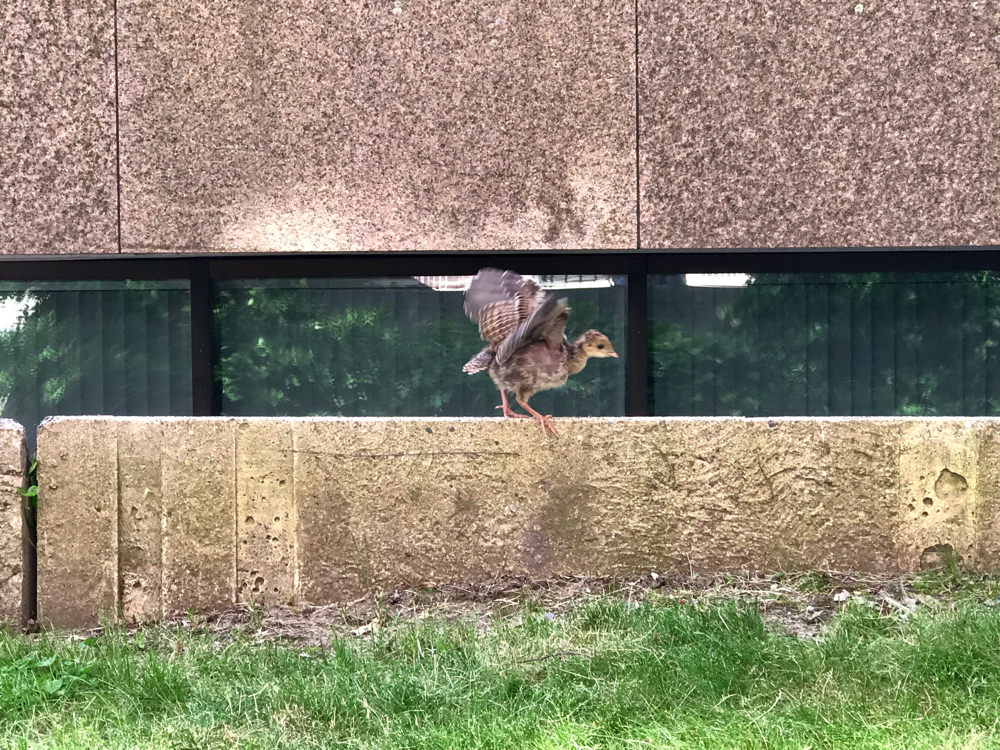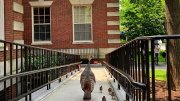Turkeys are usually associated with Thanksgiving season, but the best time to view them might be in late spring, when, after a month-long brooding period, baby turkeys hop out of their eggs and begin to forage alongside their protective mothers. This past week, to the delight of passersby, a hen turkey and her seven poults appear to have settled near the eastern end of Harvard Yard, by Lamont, Widener, and Houghton libraries.
“ATTENTION: THERE IS CURRENTLY A MAMA TURKEY AND HER BABY TURKEYS RUMMAGING AROUND #HARVARDYARD,” Amanda Steinberg, a librarian at the Fine Arts Library, tweeted June 5. “THE BABIES ARE JUST AS AWKWARD AS ADULTS BUT IMPOSSIBLY CUTE & ALSO IMPOSSIBLE TO PHOTOGRAPH….”
The birds have been seen poking around for food, testing out their new wings, or just enjoying the sunlight. Access Services librarian Laura Sherriff said that she’s seen the family about six times in the last week, most recently on Monday. “The mother turkey is the most relaxed turkey I have ever seen,” she wrote in an email. “She does not seem to mind the people taking pictures and walking by her in the yard, and people have been pretty respectful about keeping a bit of distance.”

Photograph by Allison Kern /Harvard Magazine
Turkeys have been a regular presence at Harvard for years, said Richard Pollack, the University’s senior environmental public-health officer, whose job it is to know about all of the animals on campus. “We have a bunch of different, really neat birds,” he added. A pair of hawks has settled on a ledge of the Smith Campus Center; falcons have also been seen hanging around. Visitors might be frightened by the sight of such large birds, and unsure how to behave around them. But the turkeys are nothing to be alarmed by: they have thrived in urban areas ever since they were reintroduced in Massachusetts in the 1970s, after being hunted to extinction by the mid nineteenth century. Today, there are an estimated 30,000 to 35,000 turkeys in the state. “For 10 years or more in Boston, there’ve been plenty,” said Joan Walsh, Mass Audubon Bertrand Chair of Field Ornithology and Natural History.
“Turkeys are quite adaptable, and what you see with a hen being able to pull off a brood in Harvard Yard is one of their superpowers,” Walsh explained. “They can be right next to you sitting on a nest, and you won’t see them—which she obviously pulled off. They’re incredibly well camouflaged, the females, and they’re extremely circumspect. They don’t move when danger comes near….I’ve had turkey nests within three feet of my foot that I didn’t see until I was that close, and I’m a professional….They’re the size of a small golden retriever. It’s hard to hide something that big.”
The birds’ breeding season begins in late February or March, Walsh explained: “The males do this slow dance, sort of like turkey tai chi, with their tails up. They walk very, very slowly, posturing to each other in these subtle ways. The females watch this from a distance and make a choice.” Mothers find a safe space to build their nests, and lay eight to 12 eggs at a time, each about three times the size of a chicken egg. Between around May 10 to May 20, the poults begin to hatch, and they remain with their mothers for 10 months. The babies are precocial, able to run around as soon as they emerge. Sometimes a group of hens will form a preschool, Walsh said, “so you can see three females with 10 or 12 babies behind them.” As early two and a half to three weeks, they can fly, eventually helping them roost in trees to avoid predators.
If people see turkeys wandering around Cambridge, Pollack said, “Usually, we suggest people leave them alone, keep their distance, enjoy them, let the turkeys do what turkeys do.” Feeding them, he added, is a “well-intentioned but terribly misguided activity….They’re very good at fending for themselves. Anything that a person would put out is not necessarily going to be healthy. They don’t need white bread.”

Over the years, Pollack has seen it all: turkeys leaving their droppings on University buildings, the occasional turkey being aggressive toward students, or, more often, students being aggressive toward the turkeys—which they may not realize is illegal. “We’ve had a couple of incidents where we’ve had students chasing the turkeys,” he said. “Turkeys are protected creatures….You cannot harass these birds. You can’t harm them.”
The federal Migratory Bird Treaty Act, which celebrated its centennial last year, protects turkeys and hundreds of other wild bird species, Walsh explained, except during specifically designated hunting seasons for specific species. “So that means, technically, if you found a robin nest and you thought it was really cool looking and put it in the corner of your room, you’re actually breaking the law. It’s a law that the Trump administration is working very hard to eviscerate. But it is illegal to harass wild birds.”
And why would anyone want to? she asked. “When nature surprises you with something like a wild turkey in Harvard Yard, it should be something that strikes awe in your heart….these are precious and wonderful moments, and we have fought hard for them in this country.”
As for the Yard poults, Walsh said, Harvard is likely a difficult place for them to grow up. Between feral cats, coyotes, and cars, the city is full of hazards for a young bird. Many poults don’t survive, and when they don’t, hens often try to have a second or third brood during the summer. But that they have pulled through this far is a promising sign, and, as Walsh points out, they have an ever surprising instinct for self-preservation. If they appear to be missing from their spot in the Yard, they may just be hiding in plain sight.









